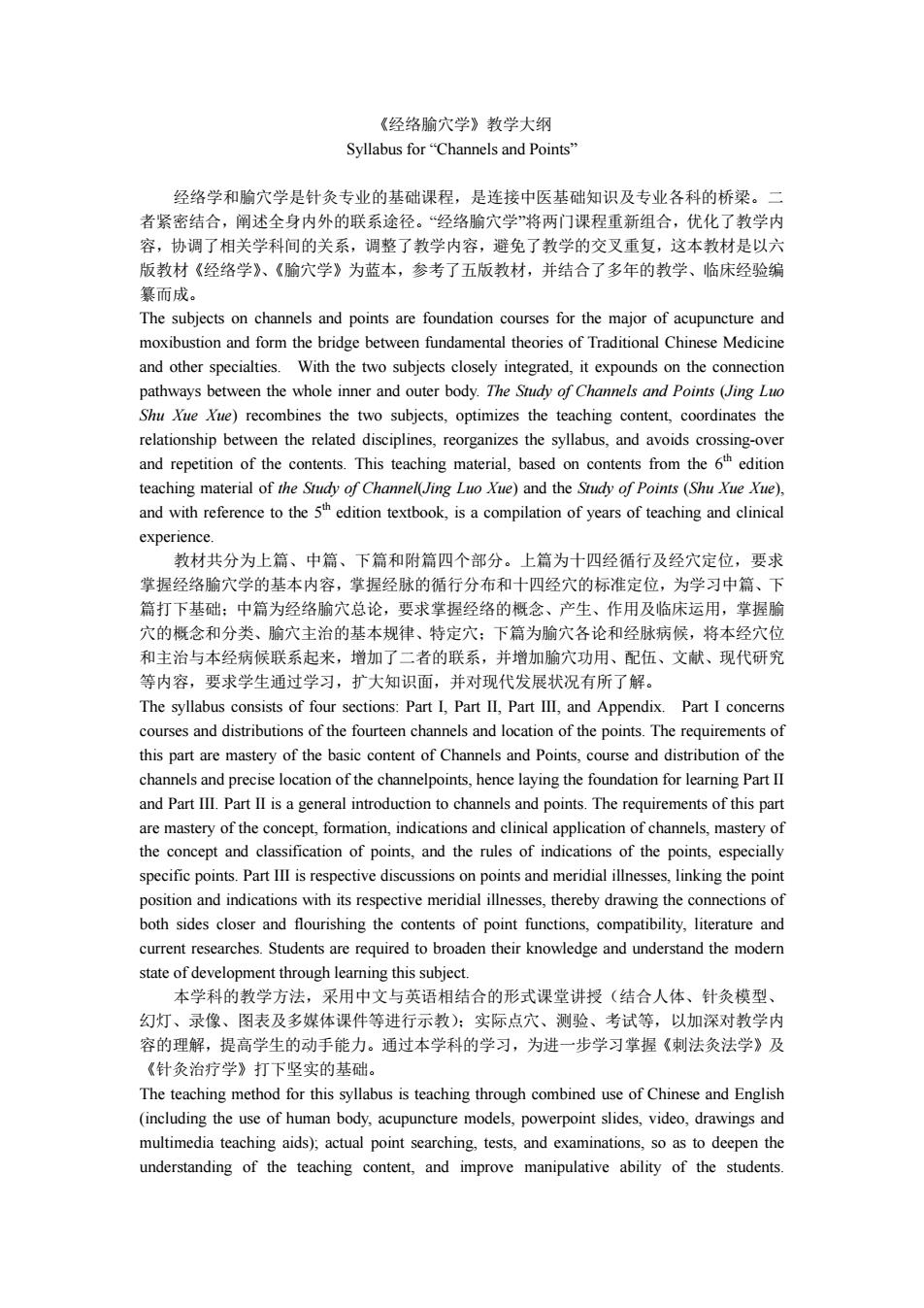正在加载图片...

《经络腧穴学》教学大纲 Syllabus for "Channels and Points" 经络学和腧穴学是针灸专业的基础课程,是连接中医基础知识及专业各科的桥梁。二 者紧密结合,阐述全身内外的联系途径。“经络腧穴学”将两门课程重新组合,优化了教学内 容,协调了相关学科间的关系,调整了教学内容,避免了教学的交叉重复,这本教材是以六 版教材《经络学》、《腧穴学》为蓝本,参考了五版教材,并结合了多年的教学、临床经验编 纂而成。 The subjects on channels and points are foundation courses for the major of acupuncture and moxibustion and form the bridge between fundamental theories of Traditional Chinese Medicine and other specialties.With the two subjects closely integrated,it expounds on the connection pathways between the whole inner and outer body.The Study of Channels and Points (Jing Luo Shu Xue Xue)recombines the two subjects,optimizes the teaching content,coordinates the relationship between the related disciplines,reorganizes the syllabus,and avoids crossing-over and repetition of the contents.This teaching material,based on contents from the 6th edition teaching material of the Study of Channel(Jing Luo Xue)and the Study of Points (Shu XueXue), and with reference to the 5h edition textbook,is a compilation of years of teaching and clinical experience. 教材共分为上篇、中篇、下篇和附篇四个部分。上篇为十四经循行及经穴定位,要求 掌握经络腧穴学的基本内容,掌握经脉的循行分布和十四经穴的标准定位,为学习中篇、下 篇打下基础:中篇为经络腧穴总论,要求掌握经络的概念、产生、作用及临床运用,掌握腧 穴的概念和分类、腧穴主治的基本规律、特定穴:下篇为腧穴各论和经脉病候,将本经穴位 和主治与本经病候联系起来,增加了二者的联系,并增加腧穴功用、配伍、文献、现代研究 等内容,要求学生通过学习,扩大知识面,并对现代发展状况有所了解。 The syllabus consists of four sections:Part I,Part II,Part III,and Appendix.Part I concerns courses and distributions of the fourteen channels and location of the points.The requirements of this part are mastery of the basic content of Channels and Points,course and distribution of the channels and precise location of the channelpoints,hence laying the foundation for learning Part II and Part IIl.Part II is a general introduction to channels and points.The requirements of this part are mastery of the concept,formation,indications and clinical application of channels,mastery of the concept and classification of points,and the rules of indications of the points,especially specific points.Part IlI is respective discussions on points and meridial illnesses,linking the point position and indications with its respective meridial illnesses,thereby drawing the connections of both sides closer and flourishing the contents of point functions,compatibility,literature and current researches.Students are required to broaden their knowledge and understand the modern state of development through learning this subject. 本学科的教学方法,采用中文与英语相结合的形式课堂讲授(结合人体、针灸模型、 幻灯、录像、图表及多媒体课件等进行示教):实际点穴、测验、考试等,以加深对教学内 容的理解,提高学生的动手能力。通过本学科的学习,为进一步学习掌握《刺法灸法学》及 《针灸治疗学》打下坚实的基础。 The teaching method for this syllabus is teaching through combined use of Chinese and English (including the use of human body,acupuncture models,powerpoint slides,video,drawings and multimedia teaching aids);actual point searching,tests,and examinations,so as to deepen the understanding of the teaching content,and improve manipulative ability of the students.《经络腧穴学》教学大纲 Syllabus for “Channels and Points” 经络学和腧穴学是针灸专业的基础课程,是连接中医基础知识及专业各科的桥梁。二 者紧密结合,阐述全身内外的联系途径。“经络腧穴学”将两门课程重新组合,优化了教学内 容,协调了相关学科间的关系,调整了教学内容,避免了教学的交叉重复,这本教材是以六 版教材《经络学》、《腧穴学》为蓝本,参考了五版教材,并结合了多年的教学、临床经验编 纂而成。 The subjects on channels and points are foundation courses for the major of acupuncture and moxibustion and form the bridge between fundamental theories of Traditional Chinese Medicine and other specialties. With the two subjects closely integrated, it expounds on the connection pathways between the whole inner and outer body. The Study of Channels and Points (Jing Luo Shu Xue Xue) recombines the two subjects, optimizes the teaching content, coordinates the relationship between the related disciplines, reorganizes the syllabus, and avoids crossing-over and repetition of the contents. This teaching material, based on contents from the 6 th edition teaching material of the Study of Channel(Jing Luo Xue) and the Study of Points (Shu Xue Xue), and with reference to the 5 th edition textbook, is a compilation of years of teaching and clinical experience. 教材共分为上篇、中篇、下篇和附篇四个部分。上篇为十四经循行及经穴定位,要求 掌握经络腧穴学的基本内容,掌握经脉的循行分布和十四经穴的标准定位,为学习中篇、下 篇打下基础;中篇为经络腧穴总论,要求掌握经络的概念、产生、作用及临床运用,掌握腧 穴的概念和分类、腧穴主治的基本规律、特定穴;下篇为腧穴各论和经脉病候,将本经穴位 和主治与本经病候联系起来,增加了二者的联系,并增加腧穴功用、配伍、文献、现代研究 等内容,要求学生通过学习,扩大知识面,并对现代发展状况有所了解。 The syllabus consists of four sections: Part I, Part II, Part III, and Appendix. Part I concerns courses and distributions of the fourteen channels and location of the points. The requirements of this part are mastery of the basic content of Channels and Points, course and distribution of the channels and precise location of the channelpoints, hence laying the foundation for learning Part II and Part III. Part II is a general introduction to channels and points. The requirements of this part are mastery of the concept, formation, indications and clinical application of channels, mastery of the concept and classification of points, and the rules of indications of the points, especially specific points. Part III is respective discussions on points and meridial illnesses, linking the point position and indications with its respective meridial illnesses, thereby drawing the connections of both sides closer and flourishing the contents of point functions, compatibility, literature and current researches. Students are required to broaden their knowledge and understand the modern state of development through learning this subject. 本学科的教学方法,采用中文与英语相结合的形式课堂讲授(结合人体、针灸模型、 幻灯、录像、图表及多媒体课件等进行示教);实际点穴、测验、考试等,以加深对教学内 容的理解,提高学生的动手能力。通过本学科的学习,为进一步学习掌握《刺法灸法学》及 《针灸治疗学》打下坚实的基础。 The teaching method for this syllabus is teaching through combined use of Chinese and English (including the use of human body, acupuncture models, powerpoint slides, video, drawings and multimedia teaching aids); actual point searching, tests, and examinations, so as to deepen the understanding of the teaching content, and improve manipulative ability of the students